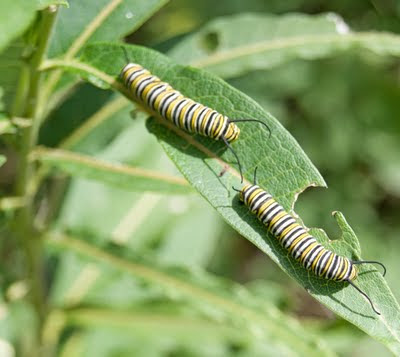Over the course of several years, I've been pulling up most of the milkweed I find around the yard. There are a few pockets that remain, however, including a half dozen plants directly under the western corner of the deck. A few weeks ago I noticed one of these plants was being heavily attacked by what turned out to be the caterpillars of the Milkweed Tussock Moth. (more here.) The moth itself is rather bland being a nondescript light brown in color and sort of a stumpy looking thing of only an inch or so in length. The caterpillar is anything but drab.
The eggs of the Milkweed Tussock Moth are laid in large clusters and 50 or more caterpillars may completely skeletonize a milkweed plant in a day or so. That's what was happening under the deck. Entire leaves of milkweed were being devoured with only the ribs of the leaf (the part carrying the latex sap) were left behind. A week after I spotted them, the caterpillars disappeared. Where they went, I've no idea. They left behind several healthy milkweed plants however.
Today there was one lonely Milkweed Tussock Moth caterpillar.
Also today, I spotted a different and more familiar caterpillar feeding on the young leaves of the milkweeds--the yellow-white-black striped Monarch Butterfly caterpillars were at work. The Monarch may go through three or four generations in a single summer. Each except the last will live as a butterfly for only a few weeks. The final generation usually emerges from the chrysalis about the time the butterfly's favorite fall meal, goldenrod, comes into flower. This is the group of Monarchs that migrates southward during the autumn.
The goldenrod around the yard is just now starting to turn yellow so this group of caterpillars--and I counted at least six on two plants--will be the ones to make that long journey. Eat hardy, my friends!


No comments:
Post a Comment